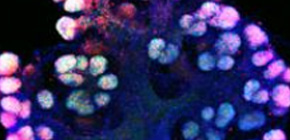
Lactoferrin‘s role in organ formation and radioprotective effects identified
Existing drugs help embryonic organ formation and prevention of irradiation damage
A group of researchers led by Professor SAKAI Takayoshi at the Graduate School of Dentistry clarified that Lactoferrin (LF) induced the formation of embryonic salivary glands and was effective in treating salivary glands damaged by radiation treatment, a world first.
Radiotherapy is an effective form of treatment for patients with head and neck cancer, but it damages salivary glands, causing oral disorders such as xerostomia (oral dryness) and swallowing problems. There is a symptomatic treatment but no basic remedy for functional recovery, so the development of new generative medicine is anticipated.
LF is included in human milk, especially in human colostrum (“first milk”) during the first few days of lactation. A newborn baby ingests LF, immunoglobulin, and lactoperoxidase with the first milk. It was thought that LF and these bioactive components helped protect newborn babies from illness.
LF became available on the market as a supplement and its positive effects on antioxidant property, bone growth, fat metabolism, and wound healing have been reported; however, no effects on organ formation and irradiation damage have been reported. LF effects on prevention of irradiation damage was reported recently; however, effects on organs were unknown. Orally administered LF is metabolized in the digestive tract, so full effects were not achieved even when it reached organs.
This group clarified that administration of LF to mouse salivary gland organ culture in the embryonic stage induced organ formation and that injection of LF to the abdominal cavity of adult mice after irradiation prevented damage to salivary glands. This will lead to the development of regenerative medicine using existing medicines and supplements including LF.
Abstract
Radiotherapy is commonly used in patients with head and neck cancer, and usually results in irreversible salivary glands damage and hypofunction. It is therefore important to manage such irradiation to prevent damage to the salivary glands. A previous study showed that Lactoferrin (LF) has a radioprotective effect, but the mechanism was not determined in salivary glands. In the present study, we investigated the detailed radioprotective effect of LF using both ex vivo submandibular salivary gland organ culture and ICR male mice in vivo. We found that LF had effects on both cell proliferation and CyclinD1-mediated cell-cycle progression which were regulated via the ERK1/2 and AKT signal transduction pathways. In addition, LF affected acinar cell structure and function after irradiation. These findings suggest that LF may be a useful agent to prevent irradiation effects in salivary glands.
Figure 1
To learn more about this research, please view the full research report entitled " Identification of the protective mechanisms of Lactoferrin in the irradiated salivary gland " at this page of Scientific Reports .
Related links
